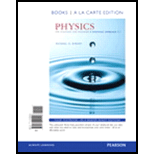
Concept explainers
I was driving along at 20 m/s, trying to change a CD and not watching where I was going. When I looked up, I found myself 45 m from a railroad crossing. And wouldn’t you know it, a train moving at 30 m/s was only 60 m from the crossing. In a split second, I realized that the train was going to beat me to the crossing and that I didn’t have enough distance to stop. My only hope was to accelerate enough to cross the tracks before the train arrived. If my reaction time before starting to accelerate was 0.50 s, what minimum acceleration did my car need for me to be here today writing these words?
Want to see the full answer?
Check out a sample textbook solution
Chapter 2 Solutions
Physics for Scientists and Engineers: A Strategic Approach with Modern Physics, Books a la Carte Edition; Student Workbook for Physics for Scientists ... eText -- ValuePack Access Card (4th Edition)
- Why can't this be correct: &= 7m?arrow_forwardgive a brief definition of the word "paradigm" as well as an example of a current scientific paradigmarrow_forward7. Are all scientific theories testable in the commonly understood sense? How does this make you feel? How should you proceed as a scientist or engineer with this understanding?arrow_forward
- What is an an example of a hypothesis that sounds scientific but is notarrow_forwardWhat is an example of a scientific hypothesisarrow_forwardMultiverse is called a theory. It has been proposed to account for the apparent and uncanny fine tuning of our own universe. The idea of the multiverse is that there are infinite, distinct universes out there - all with distinct laws of nature and natural constants - and we live in just one of them. Using the accepted definition of the universe being all that there is (matter, space and energy), would you say that multiverse is a scientific theory?arrow_forward
- How is a law usually different than a theoryarrow_forwardA 1.50 mLmL syringe has an inner diameter of 5.00 mmmm, a needle inner diameter of 0.270 mmmm, and a plunger pad diameter (where you place your finger) of 1.2 cmcm. A nurse uses the syringe to inject medicine into a patient whose blood pressure is 140/100. Part A What is the minimum force the nurse needs to apply to the syringe? Express your answer with the appropriate units. View Available Hint(s)for Part A Hint 1for Part A. How to approach the question The force the nurse applies to the syringe can be determined from the fluid pressure and the area of the plunger. The minimum force corresponds to the patient's lowest blood pressure. Use the following equality 760mmofHg=1atm=1.013×10^5Pa760mmofHg=1atm=1.013×10^5Pa.arrow_forwardA 1.50 mLmL syringe has an inner diameter of 5.00 mmmm, a needle inner diameter of 0.270 mmmm, and a plunger pad diameter (where you place your finger) of 1.2 cmcm. A nurse uses the syringe to inject medicine into a patient whose blood pressure is 140/100. Part A What is the minimum force the nurse needs to apply to the syringe? Express your answer with the appropriate units. View Available Hint(s)for Part A Hint 1for Part A. How to approach the question The force the nurse applies to the syringe can be determined from the fluid pressure and the area of the plunger. The minimum force corresponds to the patient's lowest blood pressure. Use the following equality 760mmofHg=1atm=1.013×10^5Pa760mmofHg=1atm=1.013×10^5Pa.arrow_forward
- Is a scientific theory supposed to just be someone's idea about somethingarrow_forwardwhat is the agenda of physicsarrow_forwardWatch the video of Cooper’s play, while conducting and documenting your observation using a chosen observation tool. Case Study 1b - Cooper Carol has asked you to support the babies and toddler’s room educators this week. She has requested that you complete an observation on Cooper, who is a 10-month-old toddler. Carol wants to see how well you conduct an observation and is interested in how you manage to communicate in any observations made, using a strengths-based, non-judgemental, anti-biased approach, as this is a fundamental part of creating a supportive and respectful culture at Little Catalysts ELC. Video: Cooper's play (6:45 min) Resources Module 7 eLearns Template: Learning story observation, Section 1 Template: Running record observation, Section 1 Template: Anecdotal record observation, Section 1 Video: Cooper's play (6:45 min) Complete and upload an observation of Cooper to support educators in future curriculum planning. Choose one (1) of the observation…arrow_forward
 University Physics Volume 1PhysicsISBN:9781938168277Author:William Moebs, Samuel J. Ling, Jeff SannyPublisher:OpenStax - Rice University
University Physics Volume 1PhysicsISBN:9781938168277Author:William Moebs, Samuel J. Ling, Jeff SannyPublisher:OpenStax - Rice University Principles of Physics: A Calculus-Based TextPhysicsISBN:9781133104261Author:Raymond A. Serway, John W. JewettPublisher:Cengage Learning
Principles of Physics: A Calculus-Based TextPhysicsISBN:9781133104261Author:Raymond A. Serway, John W. JewettPublisher:Cengage Learning Glencoe Physics: Principles and Problems, Student...PhysicsISBN:9780078807213Author:Paul W. ZitzewitzPublisher:Glencoe/McGraw-Hill
Glencoe Physics: Principles and Problems, Student...PhysicsISBN:9780078807213Author:Paul W. ZitzewitzPublisher:Glencoe/McGraw-Hill College PhysicsPhysicsISBN:9781305952300Author:Raymond A. Serway, Chris VuillePublisher:Cengage Learning
College PhysicsPhysicsISBN:9781305952300Author:Raymond A. Serway, Chris VuillePublisher:Cengage Learning College PhysicsPhysicsISBN:9781285737027Author:Raymond A. Serway, Chris VuillePublisher:Cengage Learning
College PhysicsPhysicsISBN:9781285737027Author:Raymond A. Serway, Chris VuillePublisher:Cengage Learning Physics for Scientists and Engineers, Technology ...PhysicsISBN:9781305116399Author:Raymond A. Serway, John W. JewettPublisher:Cengage Learning
Physics for Scientists and Engineers, Technology ...PhysicsISBN:9781305116399Author:Raymond A. Serway, John W. JewettPublisher:Cengage Learning





